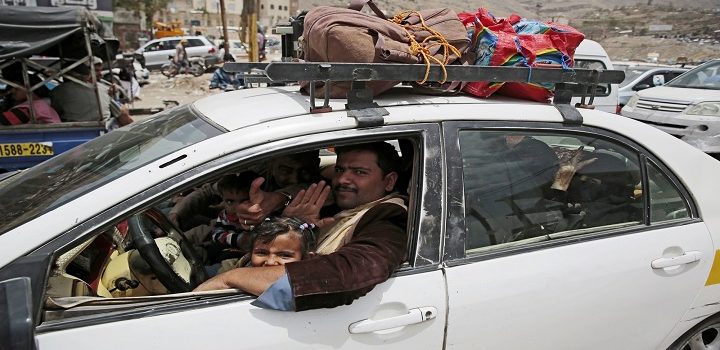UN:35 thousand families flee from Hodeida as a result of US-Saudi attack
Yamanyoon
The United Nations announced on Monday the displacement of 35 thousand families from the province of Hodeidah, About 35,000 displaced families, 20 thousand of them, received aid,” the United Nations Office for the Coordination of Humanitarian Affairs (OCHA) in Yemen said in a report issued Monday
Hodeida is a lifeline for the majority of Yemen’s population as about 70 percent of Yemen’s aid and commercial imports enter through Hodeida and the nearby Saleef port, providing food, fuel, and medicine that the population needs for survival
The report which, issued by the United Nations Office for the Coordination of Humanitarian Affairs (OCHA) in Yemen, in cooperation with the Humanitarian Partners Group, and monitoring the humanitarian situation, from 4 to 13 July in Yemen, Pointed to the continuation of air raids on Tahita and Zabaid, south of the province
OCHA noted that the situation in the port city has slightly improved and that some people have returned to their homes
“More civilians are moving within the city compared to previous weeks; shops and bakeries have reopened and water supply has improved following repairs to the main water pipeline,” it said
“However, roads leading to airport, seaport and the Sana’a– Hudaydah road remain blocked by sand and concrete barriers,” it added
The UN health agency has also warned over the “critical” conditions of civilians in Hudaydah, stressing that military operations in the key port city threaten over 70 percent of the population who are in need of relief aid
Further details, Another civilian was killed and six more were injured when airstrikes targeted a bus in the road between Zabaid and Al Jarahi cities. Saudi-led Coalition warplanes using U.S. munitions also bombed regional farms in the city of Bajel
In the lead-up to the release of a UN report focusing on displacements casualties in the Yemen war, the Saudi-led coalition that has largely been blamed for those deaths is already contesting the results of the report, some of which were leaked to the press late last month
Thousands of families have fled as aggression coalition forces ramp-up indiscriminate airstrikes in a bid t. UAE Apache helicopters have been striking schools and homes in resident area
The suffering of Yemen’s internally displaced people is severe. Some have relatives in Sanaa and other places outside of Hodeida, but many do not, forcing families to seek shelter in small makeshift tents inside of unfinished buildings, on the edges of roads, and sometimes even in waste dumps
Most of them spend their time begging for food in the street, oftentimes relying on remnants of bread and rice to satisfy their children’s hunger. As the situation continues to deteriorate, most are unable to find jobs or secure a regular source of income
Others, deciding their prospects are bleak anywhere they go, have entrenched themselves in their homes. Sauad, a 50-year-old mother of six living in Hodeida, has been unable to flee her home. Her husband died from cholera last year and she now faces constant bombardment, a lack of clean water, and power cuts
Additionally, on Tuesday, the International Organization for Migration (IOM) said that half of the Yemeni population is living in areas directly affected by the conflict and that more than two thirds would require humanitarian aid during 2018
IOM spokesman Joel Millman estimated that almost 90 percent of all internally displaced persons (IDPs) have been displaced for at least one year or more.“The protracted nature of the displacement is straining IDPs and host communities’ abilities to cope,” he added
source: agencies

